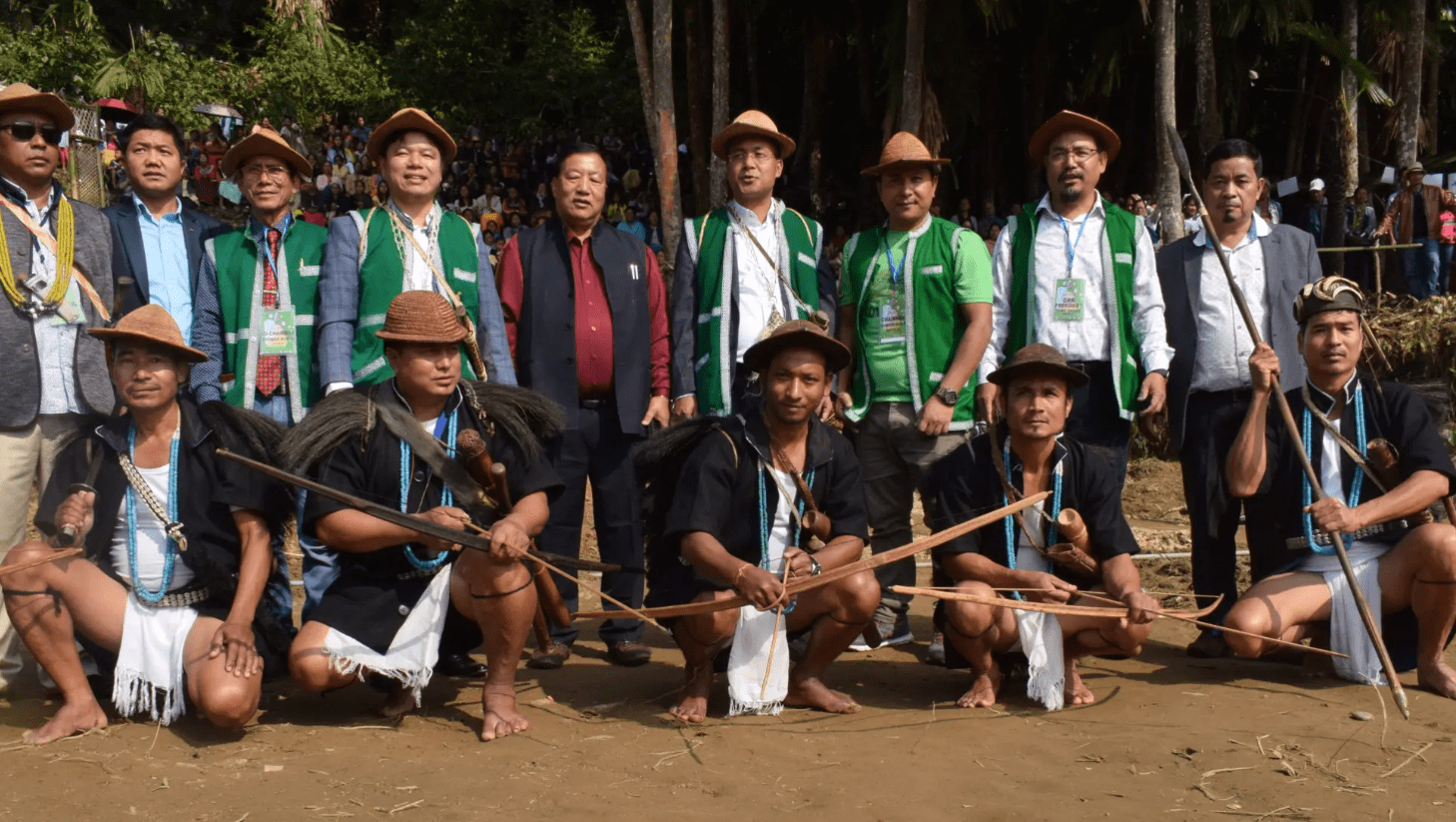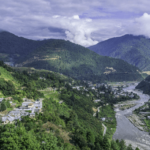If you purchase a cup of tea, a tree will be planted in your name. This delightful initiative caught my attention in Basar at Bascon 3.0. Being an avid tea lover, the idea that my simple purchase could contribute to a greener planet was heartwarming. At the “Tea for Nature” stall during the Basar Confluence, you could buy a cup of tea, and the proceeds would be used to plant a tree in your honor.
To be honest, Basar had never crossed our minds before. But our visit during Bascon 3.0 completely changed our perspective. We discovered the enchanting beauty of the place and realized why it deserves a spot on every traveler’s itinerary. Basar, during the Basar Confluence or Basar Festival, left us deeply impressed and inspired.
What is Bascon? Is it just another Festival?
Certainly not! Bascon is far more than just another festival. It is a grand celebration of the traditions, culture, art, and life of the Galo tribes, the inhabitants of Basar. Bascon stands for Basar Confluence, a three-day annual festival initiated by a local non-profit organization, Gumin Rego Kilaju (GRK).
Basar Confluence harmonizes ancient wisdom with modern innovations. It serves as a platform where Basar proudly displays traditional arts, drama, folk music, and dance forms of the Galo and other Arunachal tribes. Traditional sports are also showcased. The evenings are brought to life with mesmerizing musical performances that captivate Basar.
Bascon is a time for the Basar community to unite. Even those who have moved away due to their professions return during these days to celebrate together.
GRK – The Force Behind Bascon
Gumin Rego Kilaju (GRK), an organization formed by government officials in Basar, plays a pivotal role in the sustainable and economic development of the region. GRK is actively involved in various social initiatives, including conservation efforts, river cleaning, banning hunting, sports activities, and providing counseling and guidance for students.
Living harmoniously with each other and with nature is crucial.
This concept is beautifully embedded in the scenic hills of Basar, a destination often overlooked by travelers. GRK members are striving to put Basar on the tourism map, with Bascon as the centerpiece. The organization’s objective is perfectly encapsulated by its President, Mr. Tomo Basar, who is also the driving force behind Basar Confluence.
Many GRK members we met are highly successful in their professional lives. Yet, they found the time to come together and organize this cultural extravaganza.
Basar Confluence is organized by the people of Basar with great reverence and love. It is a collective effort, with each village assigned specific responsibilities, and they executed them with the utmost dedication.
And this community spirit is one of the most remarkable aspects of Bascon.
More About Bascon 3.0
When we first heard about the Basar Confluence, we knew we had to experience it. Bascon 3.0 spanned three days, filled with vibrant colors and joyous activities. Traditional dances, folk music performances, local jamming sessions, and much more made it an unforgettable experience. We were so engrossed in the festivities that we barely noticed how quickly the three days passed.
The melodies of Galo folk songs captivated us, and the rhythmic beats of the War Dance had us moving to the music. We hummed along with the soulful tunes of local bands and performers. Of course, we indulged in the local cuisine and drinks, learned about the Galo way of life at the Live Galo Museum, and even participated in farming activities at the Agri Tourism Point. The entire experience was immersive and unforgettable.
Highlights of Bascon 3.0
Galo Ponu
The first spectacle we encountered upon arriving at the festival grounds was the Galo Ponu. It was indeed a spectacular sight. Hundreds of Galo women, dressed in vibrant traditional attire, formed a large circle around the grounds. Ponu is a local dance form performed on various occasions, and in this case, it served as a welcoming dance. The dance can involve any number of participants, led by a Ponu leader who narrates folklore, stories, and myths through song, with the dancers repeating the refrain. The Ponu leader also holds a sword upside down, shaking it to produce a rattling sound.
It was a magnificent sight, with women from various Basar villages participating in the dance. Each village was represented by a group of women in distinctively colored costumes, creating a visually stunning display.
Nyida Parik
Nyida Parik is the Galo wedding dance. In fact, the term “Nyida” refers to the marriage ceremony in the Galo language. The dance, performed by men dressed in black and white, is a rhythmic spectacle that resonates with the beat of metal plates. The Galos believe this dance was first performed during the marriage of Abo-Tani (the father of all human beings) and Donyi Mumsi, the daughter of Donyi Polo, the Sun god. The men, adorned with striking headdresses, performed the dance with such grace that the onlookers were left in awe.
Mega Galo Dance
The Mega Galo Dance truly lives up to its name. Nearly 200 women, dressed in a kaleidoscope of colors, performed to an infectious Galo tune. This dance was undoubtedly the most vibrant event of the entire festival. The Galo women showcased their grace and teamwork in this stunning performance. The sheer number of dancers and the festive atmosphere reminded me of the Hundred Drums Wangala Festival in Meghalaya, where 300 dancers perform to the rhythm of 100 drums. The Mega Galo Dance was equally spectacular!
Mopin Showcase
Mopin Festival is one of the major celebrations of the Galo tribe, observed as a pre-agricultural festival in March or April to ensure a good harvest. Mopin worships the Mopin Ane deity, who symbolizes wealth and prosperity for the Galo people. She is both a protector and a provider, akin to Goddess Lakshmi and Goddess Annapurna in Hinduism. At the Mopin showcase during Bascon, we heard stories about Mopin rituals. We might write a post about it after witnessing the Mopin Festival firsthand!
Bascon offered us a glimpse of the Mopin Festival. As the deities arrived on a raft at the riverbank, they were welcomed by dancers dressed in pristine white. The deities were honored, and men and women performed ritualistic dances as part of the Mopin showcase. This preview of Mopin left us eager to experience the full festival in March.
Lion Dance
The Lion Dance, performed by artists from Tawang, left us spellbound. I had previously witnessed the Lion Dance during Chinese New Year celebrations, but this performance surpassed all expectations. To the beat of pulsating music, two snow lions appeared, followed by a saint. The dance tells the story of a Lama who meditated in the mountains and was sustained by the milk of two snow lions. This story, along with the dance, beautifully illustrates the harmony between man, animal, and nature. The lions were later joined by a peacock in the dance. Two performers inside the lion costume danced together in perfect synchronization. It was a mesmerizing performance!
Traditional Fishing Day
The second morning of Bascon 3.0 was dedicated to traditional fishing, a unique and communal activity among the Galos. The villagers gather to fish using traditional methods.
To catch freshwater fish, the villagers create a barrier of stones on the riverbed to slow the water’s flow. They also prepare a mesh-like structure from split bamboo and place it on the riverbed. The river is divided into three sections, each with different-sized mesh to capture various fish sizes.
Women use conical bamboo baskets to trap smaller fish, while men catch larger fish using poisoned herbs that temporarily hinder their movement. These fish are then caught with long bamboo sticks fitted with sharp objects.
Traditional Fishing at Basar
Basar has now banned fishing to preserve fish species, but one day during Bascon is reserved for traditional fishing, allowing younger generations to learn sustainable fishing methods.
Traditional Sports Competition
The traditional sports competition at Bascon was another exciting event that had the crowds cheering. The Galo people take immense pride in their traditional sports. Archery, acrobatics, and other traditional games were part of the competition, supported enthusiastically by all the villages. Nyarka Hinam, where participants wrestle with a bamboo pole within a circle, was a crowd favorite. Traditional archery, known as Geppe Abnam, involved participants aiming at still and moving targets. Baabo Renam, a tightrope walking challenge, was both entertaining and impressive. The tug-of-war match, however, was perhaps the loudest and most eagerly watched event.
Artist Residency
Bascon also hosted an Artist’s Residency where artists from various fields lived in Basar and created works inspired by their experiences. This year’s participants included Imon Raza, Mridul Kanti Goswami, Subhash Maskara, Rakesh Roy Choudhury, Ranju Dodum, and Dara Okat. Their artworks, displayed at the festival, captured the essence of Basar.
Music
Music was central to Bascon 3.0. The festival featured a mix of folk songs, contemporary performances, and local jam sessions. As the temperature dropped, the evenings were enlivened by performances from local bands, including Dr. Nikom Riba, Jeli and his Band, and Mojum Riram. The music transcended language barriers, resonating with everyone present.
Dance & Drama
In addition to the previously mentioned dances, Bascon showcased other Galo folk dances, including War dances and Bihu. Day 2 featured a theatrical performance that, despite language differences, was highly engaging and entertaining for the audience.
Agri & Textile Tourism
Agriculture and textile traditions were highlighted at Bascon. The festival included demonstrations of rice cultivation and traditional weaving techniques. Visitors had the opportunity to experience farming practices and purchase handmade textiles.
Storytelling
The Galo tribe’s rich oral history was shared through storytelling sessions at Bascon. Elders recounted tales of their land and traditions, adding depth to our understanding of Galo culture.
Adventure at Bascon
Beyond the cultural events, Basar offered opportunities for bird watching, trekking, cycling, and riverside camping. These activities complemented the festival experience, providing a full range of exploration options.
Cuisines
Food was a central aspect of the festival, with stalls offering traditional Galo dishes cooked in bamboo stems. Adventurous foodies could enjoy exotic local specialties and local alcohol known as “Poka,” served in bamboo containers.
Basar Confluence (Bascon) – A Green Initiative Towards Sustainable Tourism
Bascon 3.0 exemplified sustainability. The festival was plastic-free, with bamboo and leaves used for stages, seating, and food serving. Water and local alcohol were served in bamboo containers, highlighting a commitment to eco-friendly practices.
Where is Basar?
Basar, located in the Lepa Rada district of Arunachal Pradesh, is a picturesque town with surrounding villages like Gori, Hoi, Bam, and Sago. The area, situated at the confluence of the Hei and Kidi Rivers, features bamboo huts, orange orchards, and scenic farmland.
How to Reach Basar
Reaching Basar involves a journey from Silapathar, Assam, or Dibrugarh, with travel options including shared sumos. The journey, though challenging, is well worth it for the charm and beauty of Basar.


